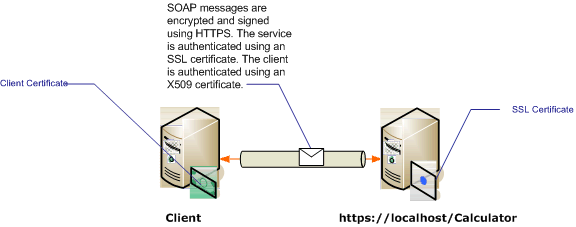Uwaga
Dostęp do tej strony wymaga autoryzacji. Może spróbować zalogować się lub zmienić katalogi.
Dostęp do tej strony wymaga autoryzacji. Możesz spróbować zmienić katalogi.
W tym artykule omówiono używanie certyfikatów X.509 na potrzeby uwierzytelniania serwera i klienta podczas korzystania z zabezpieczeń transportu. Aby uzyskać więcej informacji na temat certyfikatów X.509, zobacz X.509 Public Key Certificates (Certyfikaty kluczy publicznych X.509). Certyfikaty muszą być wystawiane przez urząd certyfikacji, który jest często wystawcą certyfikatów trzeciej strony. W domenie systemu Windows Server usługi certyfikatów Active Directory mogą służyć do wystawiania certyfikatów na komputerach klienckich w domenie. W tym scenariuszu usługa jest hostowana w usługach Internet Information Services (IIS), które są skonfigurowane przy użyciu protokołu SSL (Secure Sockets Layer). Usługa jest skonfigurowana przy użyciu certyfikatu SSL (X.509), aby umożliwić klientom weryfikowanie tożsamości serwera. Klient jest również skonfigurowany przy użyciu certyfikatu X.509, który umożliwia usłudze weryfikowanie tożsamości klienta. Certyfikat serwera musi być zaufany przez klienta, a certyfikat klienta musi być zaufany przez serwer. Rzeczywista mechanika sposobu, w jaki usługa i klient weryfikuje tożsamość siebie nawzajem, wykracza poza zakres tego artykułu. Aby uzyskać więcej informacji, zobacz Podpis cyfrowy w Wikipedii.
Ten scenariusz implementuje wzorzec komunikatu żądania/odpowiedzi, jak pokazano na poniższym diagramie.

Aby uzyskać więcej informacji na temat używania certyfikatu z usługą, zobacz Praca z certyfikatami i Instrukcje: konfigurowanie portu przy użyciu certyfikatu SSL. W poniższej tabeli opisano różne cechy scenariusza.
| Charakterystyka | Opis |
|---|---|
| Tryb zabezpieczeń | Transport |
| Współdziałanie | Z istniejącymi klientami i usługami sieci Web. |
| Uwierzytelnianie (serwer) Uwierzytelnianie (klient) |
Tak (przy użyciu certyfikatu SSL) Tak (przy użyciu certyfikatu X.509) |
| Integralność danych | Tak |
| Poufność danych | Tak |
| Transport | HTTPS |
| Wiążący | WSHttpBinding |
Konfigurowanie usługi
Ponieważ usługa w tym scenariuszu jest hostowana w usługach IIS, jest skonfigurowana przy użyciu pliku web.config. W poniższej web.config pokazano, jak skonfigurować usługę WSHttpBinding do korzystania z zabezpieczeń transportu i poświadczeń klienta X.509.
<configuration>
<system.serviceModel>
<protocolMapping>
<add scheme="https" binding="wsHttpBinding" />
</protocolMapping>
<bindings>
<wsHttpBinding>
<!-- configure wsHttp binding with Transport security mode and clientCredentialType as Certificate -->
<binding>
<security mode="Transport">
<transport clientCredentialType="Certificate"/>
</security>
</binding>
</wsHttpBinding>
</bindings>
<!--For debugging purposes set the includeExceptionDetailInFaults attribute to true-->
<behaviors>
<serviceBehaviors>
<behavior>
<serviceDebug includeExceptionDetailInFaults="True" />
</behavior>
</serviceBehaviors>
</behaviors>
</system.serviceModel>
</configuration>
Konfigurowanie klienta
Klienta można skonfigurować w kodzie lub w pliku app.config. W poniższym przykładzie pokazano, jak skonfigurować klienta w kodzie.
// Create the binding.
var myBinding = new WSHttpBinding();
myBinding.Security.Mode = SecurityMode.Transport;
myBinding.Security.Transport.ClientCredentialType =
HttpClientCredentialType.Certificate;
// Create the endpoint address. Note that the machine name
// must match the subject or DNS field of the X.509 certificate
// used to authenticate the service.
var ea = new
EndpointAddress("https://localhost/CalculatorService/service.svc");
// Create the client. The code for the calculator
// client is not shown here. See the sample applications
// for examples of the calculator code.
var cc =
new CalculatorClient(myBinding, ea);
// The client must specify a certificate trusted by the server.
cc.ClientCredentials.ClientCertificate.SetCertificate(
StoreLocation.CurrentUser,
StoreName.My,
X509FindType.FindBySubjectName,
"contoso.com");
// Begin using the client.
Console.WriteLine(cc.Add(100, 1111));
//...
cc.Close();
Alternatywnie można skonfigurować klienta w pliku App.config, jak pokazano w poniższym przykładzie:
<configuration>
<system.serviceModel>
<client>
<!-- this endpoint has an https: address -->
<endpoint address=" https://localhost/CalculatorService/service.svc "
behaviorConfiguration="endpointCredentialBehavior"
binding="wsHttpBinding"
bindingConfiguration="Binding1"
contract="Microsoft.Samples.TransportSecurity.ICalculator"/>
</client>
<behaviors>
<endpointBehaviors>
<behavior name="endpointCredentialBehavior">
<clientCredentials>
<clientCertificate findValue="contoso.com"
storeLocation="CurrentUser"
storeName="My"
x509FindType="FindBySubjectName" />
</clientCredentials>
</behavior>
</endpointBehaviors>
</behaviors>
<bindings>
<wsHttpBinding>
<!-- configure wsHttpbinding with Transport security mode
and clientCredentialType as Certificate -->
<binding name="Binding1">
<security mode="Transport">
<transport clientCredentialType="Certificate"/>
</security>
</binding>
</wsHttpBinding>
</bindings>
</system.serviceModel>
<startup><supportedRuntime version="v4.0" sku=".NETFramework,Version=v4.0"/></startup></configuration>